The Roots of Cooperative Management
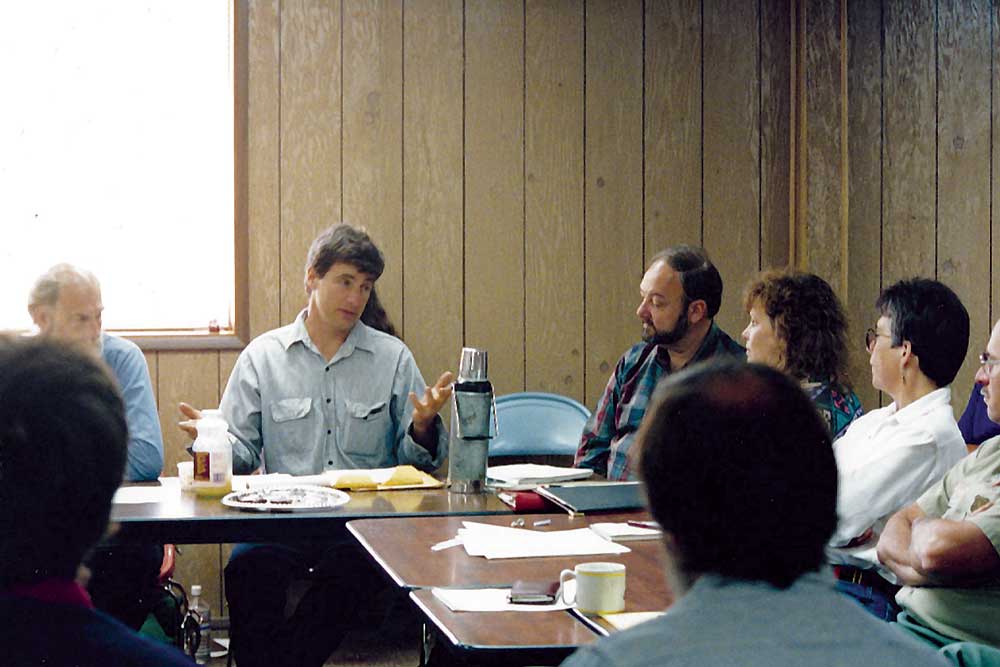
By Michael Evenson
With the formation of the Trees Foundation in 1991, founding directors Rick Klein and I sought a path for forest communities to continue to work in the woods while “restoring ecological functions,” terminology that changes with the times, but means healing from the outrageous disturbances of the past. The path to achieve this was not direct, but it cleared the way for so much of the groundbreaking work being done today.
This story began to unfold in the early ‘90s when Rick’s son played soccer in Arcata. On the sidelines of those games, Rick happened to strike up a friendship with a woman named Martha Ketelle. She was then Supervisor of Six Rivers National Forest and their conversations developed into her inviting Rick to work with her to find a new way through the gridlock of the Timber Wars. Rick pitched the idea of cooperation at an early Trees board meeting and I volunteered to pursue the interaction with Ketelle. This chance meeting coincided with President Clinton launching an initiative to quell the Timber Wars called the federal Northwest Forest Plan. It addressed the imminent threat to endangered species, led by the fate of the Northern Spotted Owl impacted by old-growth forest destruction. The Timber Wars were inflamed by individuals being pitted against each other in timber and environmental communities, and that federal plan also began to address the long-term denial of the cultural rights and knowledge of sovereign tribal nations.
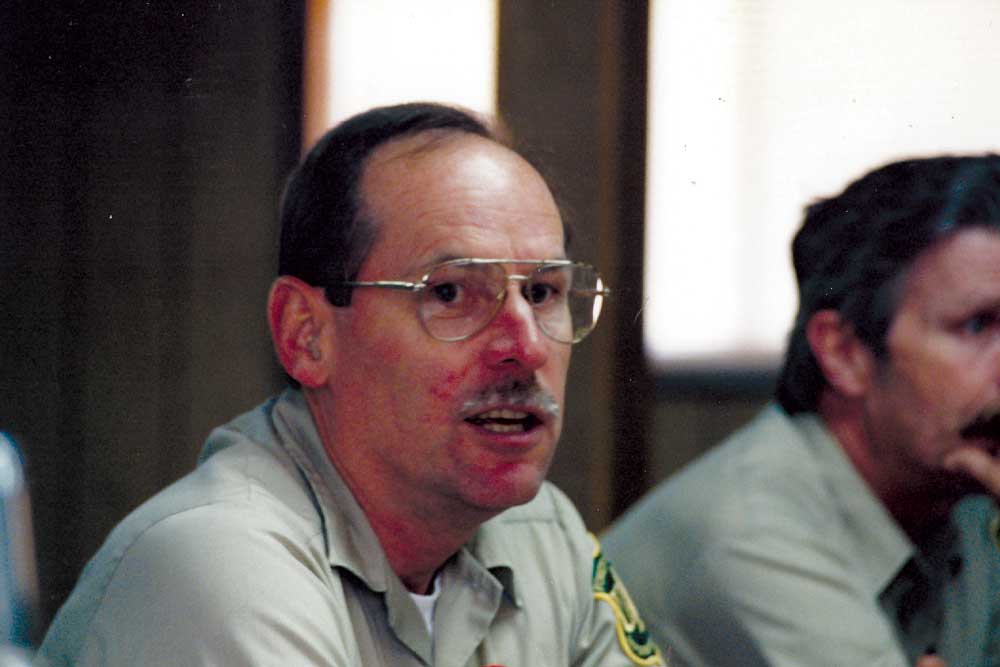
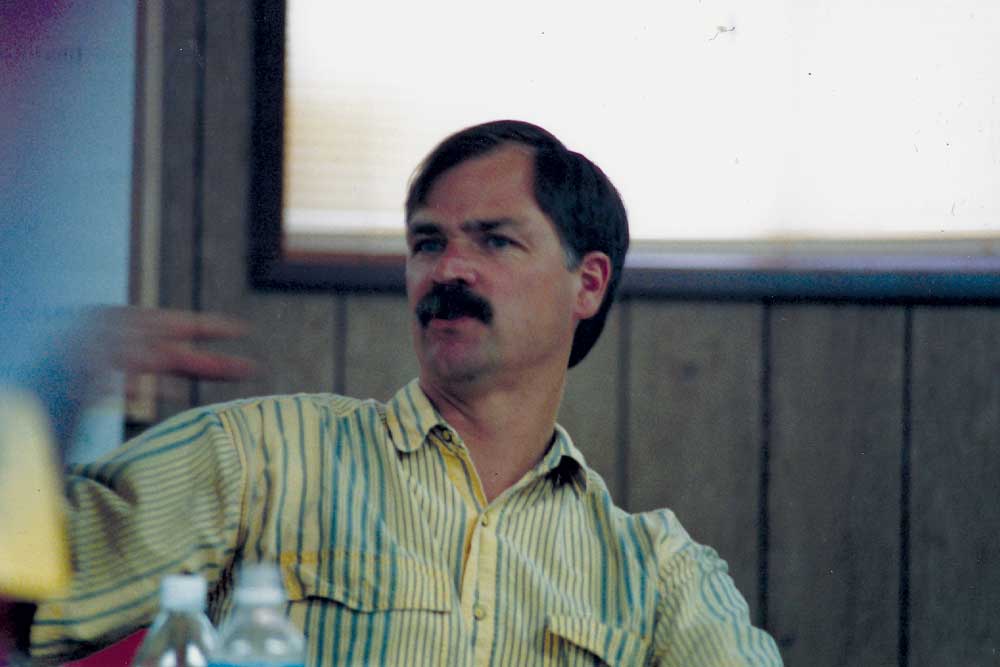
The U.S. Forest Service Collaborates with the Karuk Tribe and Trees Foundation
Ketelle invited me to join with Robert Rohde from the Karuk Tribe to determine where we could all collaborate. What followed, through negotiations, was the very first Memorandum of Understanding (MOU) in June 1993 between the U.S. Forest Service, the Karuk Tribe (a federally recognized tribe), and Trees Foundation (an environmental non-profit).
Karuk Tribal Chairman Alvis Johnson was gratified that the Karuk could finally exercise management over some part of their extensive ancestral territory that the USFS had been abusing. Their territory was nearly all within the boundaries of National Forests. The administering federal bureaucracy had no incentive to listen to cultural imperatives for use of the lands. But now, with the MOU, cultural burning in Red Cap Creek could commence to release old oak stands from the threatening Douglas-fir invasion. Burns were planned by the basket weavers to facilitate the collection of suitable materials. The plantations that followed widespread clearcutting could be thinned to nudge the landscape back into the diverse forest that existed before logging and the Douglas-fir monoculture was imposed.
Natural Resources Manager for the Karuk, Rohde commented that he never thought he’d see the day when the Forest Service would take the Tribes’ interest seriously and allow them a seat at the table to propose projects and participate in decision-making.
The partnership was productive. Representing Trees Foundation, I was instructed in historical and legal issues that faced the Tribe. Showing up for the Tribe whenever needed, I met with tribal members, and learned from conversations, meetings, historical records, and relevant legal decisions. Leaf Hillman, then Director of the Karuk Natural Resources Department, entrusted me to represent the Tribe in the Klamath Province Advisory Committee established by President Clinton to resolve administrative and resource issues among the various public agencies (USFS, NOAA Fisheries, U.S. Fish and Wildlife, National Parks) and the Tribes, timber communities, County Supervisors, the general public, and environmental advocates. The Karuk also sent me to Washington, DC to meet with federal officials there to expand the Tribe’s role in stewarding the lands. A government-to-government relationship is the basis for interaction, as such, it is a meeting of equals. These meetings laid the groundwork for improved trust between the Karuk Tribe (a sovereign nation) and the United States.
The MOU was a working framework used by the Tribe to further cultural management of federal lands. In 1994 Robert Rohde wrote to the federal team, “We are hopeful that the Watershed Analysis Work Group will recognize that through Vision 2020 we have already begun to develop a prototype for watershed analysis on federal lands.” Our Congressman Dan Hamburg lent his support for the work of Trees Foundation to continue participation in the partnership.
In 1995, Trees Foundation received Forest Service Chief Jack Ward Thomas’ Award “In the Spirit of Working Together for Rural America.” Trees Foundation was “recognized for outstanding accomplishments through cooperation with, and support to, the citizens and partners of the Orleans/Somes Bar communities to revitalize their economy while maintaining their rural lifestyle.” The Award carried with it funds to further the work.
In 2023, the U.S. government finally relinquished ownership of some of the Tribe’s most important sacred sites: Panamenik, Katimin, and Inam.
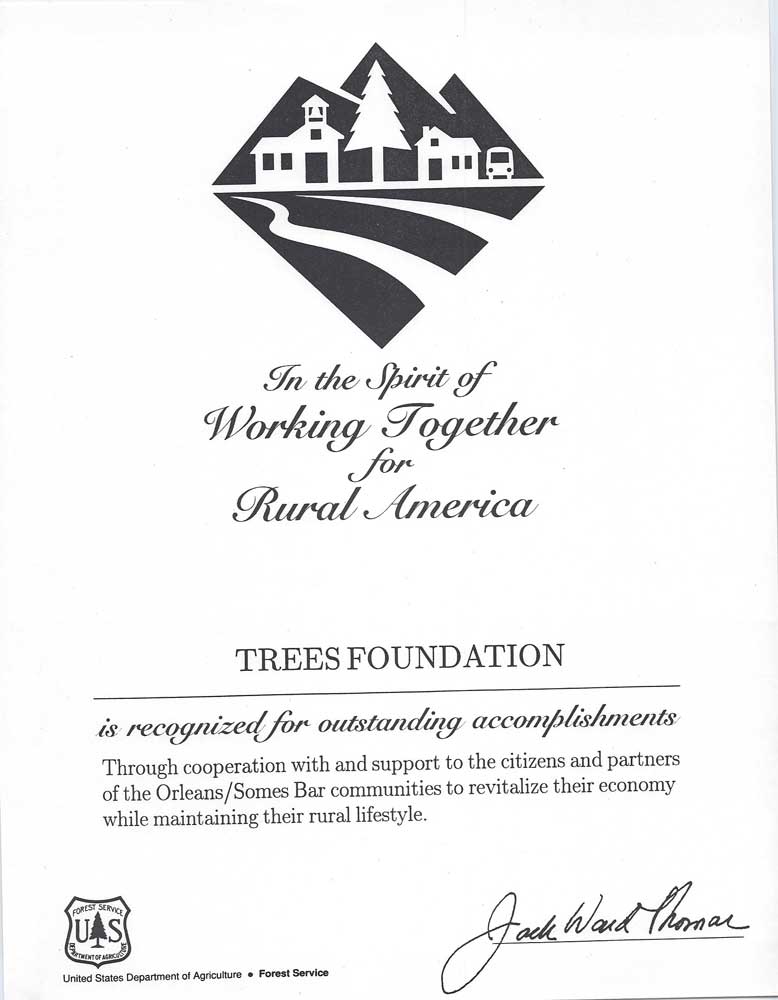
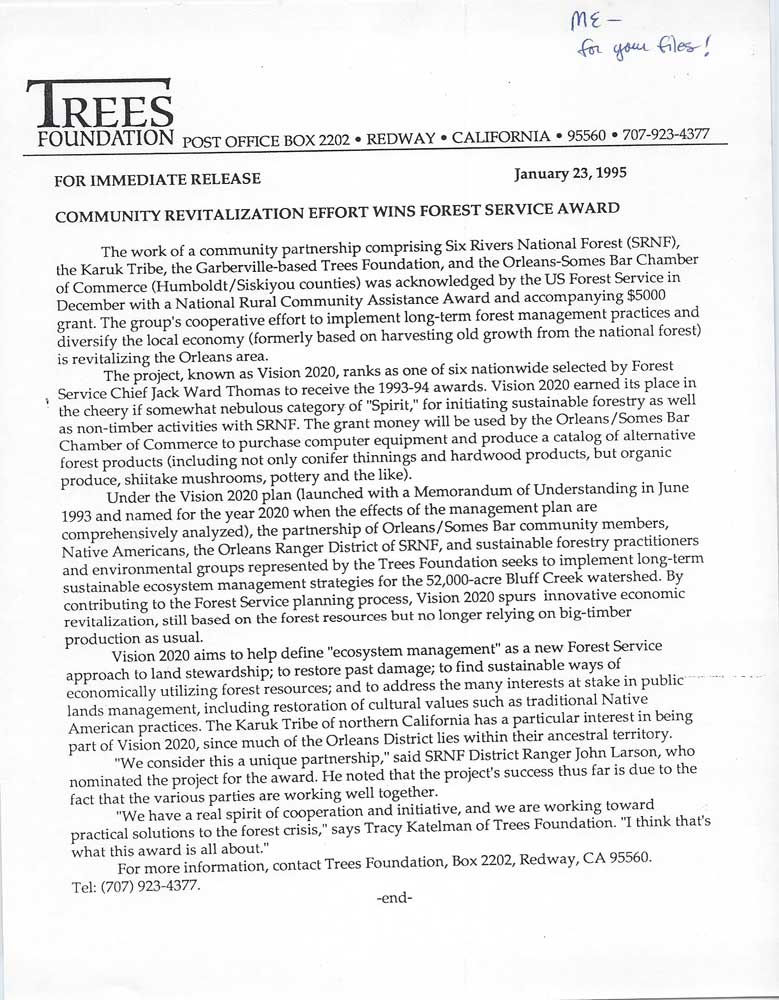
The work of a community partnership comprising Six Rivers National Forest, the Karuk Tribe, the Garberville-based Trees Foundation, and the Orleans-Somes Bar Chamber of Commerce (Humboldt/Siskiyou counties) was acknowledged by the U.S. Forest Service in 1995.
North Coast League’s Vision 2020 Project Was “New” Foresty in the Old Days
Today Cooperative Management is mandated by Governors Brown and Newsome’s Executive Orders. Leaf Hillman is currently co-chair of the North Coast Resource Partnership (NCRP) which approaches land management issues collaboratively with tribes, agencies, and local governments, by directing funding to projects. NCRP works closely with CAL FIRE to increase cultural fire opportunities. Karuk Tribe’s Kathy McCovey, a USFS employee, is leading the way to bring practitioners of burning together and accelerate the use of prescribed fire throughout the region. The Karuk Tribe Natural Resources Department, led and staffed by young tribal members, is empowered to engage as equals with the USFS to incorporate Traditional Ecological Knowledge throughout their ancestral territory.
Trees Foundation, from its inception, was at the forefront promoting management practices that embrace cultural stewardship for the health of the forest, the people, and the land. In the ensuing decades, government agencies and public entities have joined the movement to support Indigenous land stewardship.
This work is rooted in respect for each interest and the deeply held values based on regional knowledge, collaboration, and survival—in essence learning from the past to improve our future.
For more information: lostcoastleague.org
